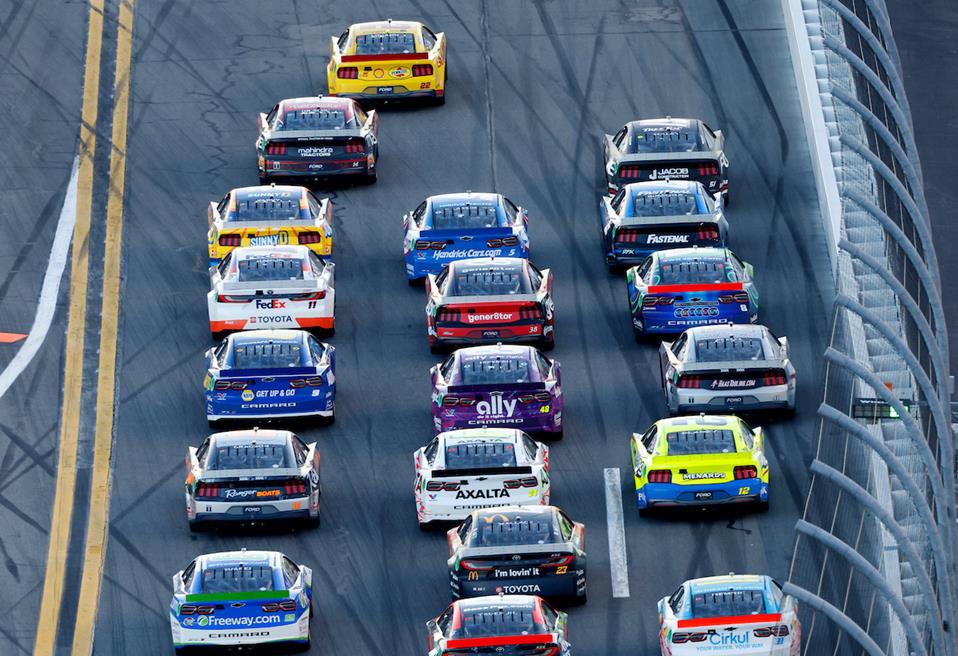By Seth Eggert, Associate Editor
NASCAR’s four crown jewel races, the Daytona 500, Coca-Cola 600, Brickyard 400 and Southern 500 each carry a level of prestige and importance. However, the amount of points to NASCAR Cup Series teams that the four crown jewels pay out is different. Equalizing the number of Stages in each race could change that and bring an end to fuel-mileage racing at Daytona.
If each of the crown jewel races had four Stages, like the Coca-Cola 600 currently does, then the importance of each race, points-wise, would be on a level playing field. With the extra stage, the marathon at Charlotte Motor Speedway currently has a maximum of 70 points and eight playoff points. All other races have a maximum of 60 points and seven playoff points available.
While the Bluegreen Vacations Duel races at Daytona Int’l Speedway. add 10 points to the Duel winners’ tallies, it’s still one playoff point shy of Charlotte’s total. The stages at ‘The World Center of Racing’ were 60-60-80 from 2017 through 2019. The stage lengths changed in 2020 to 65-65-70 to encourage green flag pit stops.

With the NASCAR Next Gen car being a different beast compared to the Gen 6 car that the current Stages were built around, a change could be necessary to discourage, or even eliminate, fuel mileage racing in ‘The Great American Race’ altogether.
“It was a really strange race,” Chris Buescher said after the 2024 Daytona 500. “One of the most frustrating races I have been a part of in a long time. Tons of fuel saving and it was all about the pit stop, one pit stop for every stage and then some massive blocks by single cars that weren’t up to speed. It is a lot different than the last go around. I didn’t have as much fun as I hoped to but we will be good for next weekend.”
Adding a fourth Stage to elevate the grandeur of the Daytona 500, could eliminate the fuel mileage racing seen on Monday. One full-fuel stint was about 53-58 laps in the race that was postponed to Monday. If the Stages were, hypothetically, 40-40-40-80, that would eliminate green flag pit stops in the first two-thirds of the race and make the final Stage long enough to force a pit stop. It also would award the same number of playoff points as the 600.
Lap times in the Daytona 500 were as much as three seconds slower than qualifying, in the mid-51 second bracket. A.J. Allmendinger, who had a pass-through penalty for a choose rule violation closed the gap to the pack down from over 32 seconds to about 22 seconds before the field stopped their extreme fuel saving.
“Running that slow was a bit surprising,” Corey LaJoie admitted about the extreme fuel saving in the Daytona 500. “But you know you had to save fuel because the more fuel you save during the run, you can kind of flip those guys on fuel on pit road. I think we played it all right. The only time I made a mistake was leaving that middle open and we got shuffled and we did all we could, but we were covered well.”
The NextGen car has yet not competed at ‘The Brickyard,’ although it has raced on Indianapolis Motor Speedway’s Grand Prix Circuit. Stages at Indianapolis’s oval could be 30-30-30-70 if NASCAR’s crown jewels were elevated onto an equal footing.
The Southern 500 already has an added importance, having served as the first race of the Cup Series Playoffs since the 2020 season. However, in 2024, due to the Olympic Break and other schedule maneuvers, the historic race at Darlington Raceway will serve as the regular season finale. A fourth stage would increase the incentive at ‘The Lady in Black.’
Prior to 2020, ‘The Track Too Tough to Tame’ was the 25th race of the season. If it were to move back out of the playoffs, a fourth Stage could replace the current 115-115-137 breakdown with something along the lines of 80-80-80-127. That would still provide the test of tire management and endurance at one of NASCAR’s oldest speedways. This could work if Darlington remains outside of the playoffs.
Unless changes are made, the Daytona 500 may carry the most prestige, the Brickyard 400 motorsports’ history, and the Southern 500 a test of skill, all three of those crown jewels take a backseat to the weight scale of an extra Stage at the Coca-Cola 600, NASCAR’s endurance test.